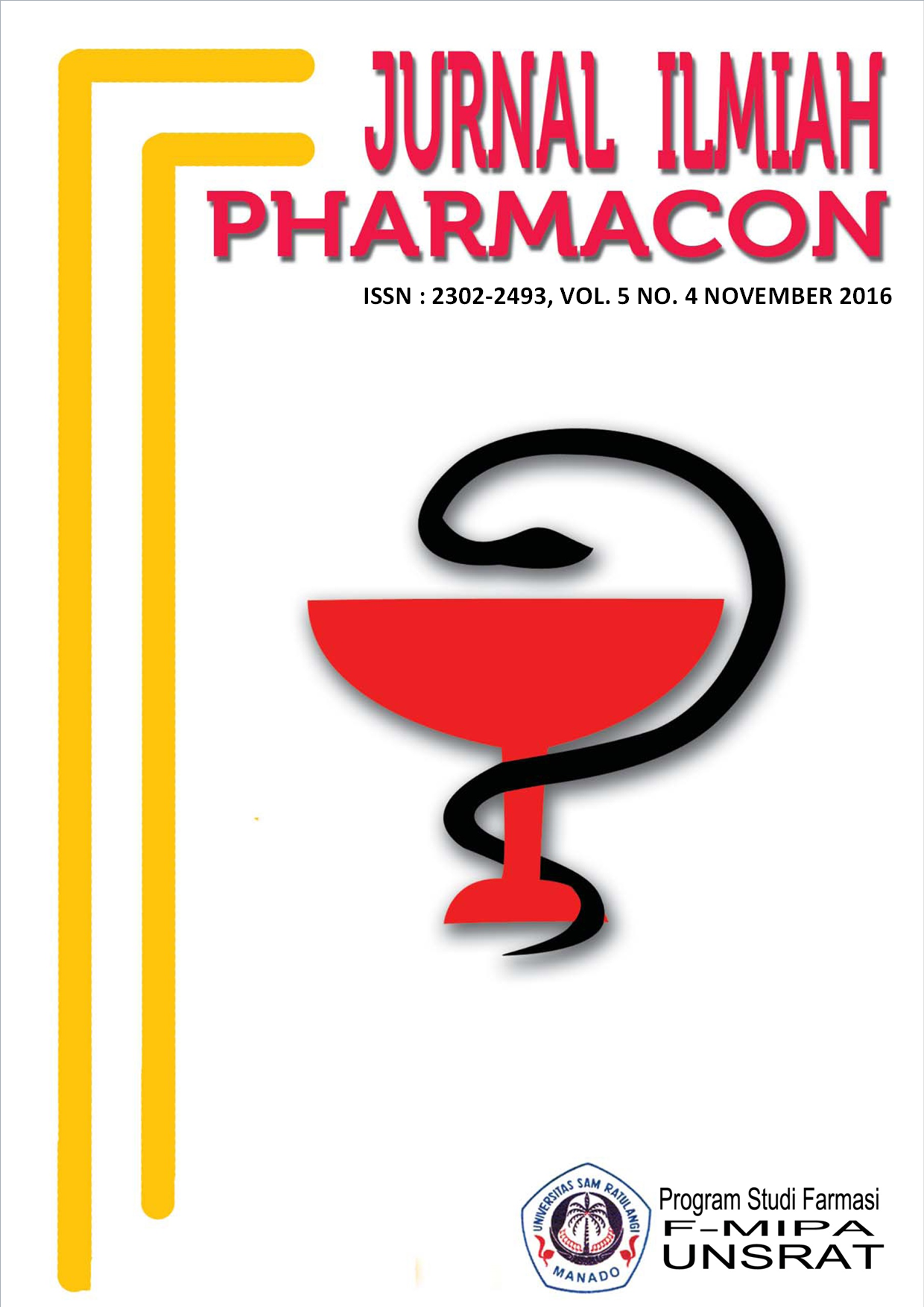UJI KONSENTRASI HAMBAT MINIMUM (KHM) EKSTRAK DAUN LEILEM (Clerodendrum minahassae L.) TERHADAP BAKTERI Streptococcus mutans
DOI:
https://doi.org/10.35799/pha.5.2016.13976Abstract
UJI KONSENTRASI HAMBAT MINIMUM (KHM) EKSTRAK DAUN LEILEM (Clerodendrum minahassae L.) TERHADAP BAKTERI Streptococcus mutans
Hanna R. R. Situmorang1), Olivia Waworuntu1), Christy Mintjelungan1)
1) Program Studi Pendidikan Dokter Gigi Fakultas Kedokteran  UNSRAT Manado, 95115
ABSTRACT
            Caries is one of the dental and oral diseases that are often experienced by the population of Indonesia. Caries is a disease of hard dental tissue , which consists of email , dentin and cementum , which is caused by the activity of microorganisms in fermentable carbohydrates. Streptococcus mutans bacteria are known to be the main cause of dental caries. Leilem leaf (Clerodendrum minahassae L.) is one of a herbal plant containing of antimicrobial compounds, namely flavonoid, fenol, steroid and terpenoid. A study has been held in Manado by Bontjura et al in 2015 proved that the extract of leilem leaf (Clerodendrum minahassae L.) could inhibit the Streptococcus mutans.The purpose of this study is to determine the minimal inhibitory concentration (MIC) of leilem leaf (Clerodendrum minahassae L.) to Streptococcus mutans. This research is a true experimental research with Randomized Pretest-Posttest Control Group Design. This method used in this study is serial dilution method with turbidimetry and spectrophotometry as the test methods. Leilem leaf was taken from Paniki, subdistrict of Mapanget, and was extracted with maceration method using ethanol 96%. Streptococcus mutans bacterial was taken from a pure bacterial stock in Pharmacy Laboratory Faculty of Mathematics and Natural Science University of Sam Ratulangi Manado.Based on this research the minimal inhibitory concentration (MIC) of leilem leaf extract (Clerodendrum minahassae L.) to Streptococcus mutans is in the concentration of 12,5%.
Keywords : leilem leaf (Clerodendrum minahassae L.), Streptococcus mutans, minimal inhibitory concentration (MIC), caries.
ABSTRAK
Karies merupakan salah satu penyakit gigi dan mulut yang sering dialami oleh penduduk Indonesia. Karies adalah suatu penyakit jaringan keras gigi, yaitu email, dentin dan sementum, yang disebabkan oleh aktivitas suatu jasad renik dalam suatu karbohidrat yang dapat diragikan. Streptococcus mutans diketahui merupakan bakteri penyebab utama timbulnya karies gigi. Ekstrak daun leilem (Clerodendrum minahassae L.) merupakan salah satu tanaman herbal yang mengandung senyawa antibakteri, yaitu flavonoid, fenol, steroid, dan terpenoid. Sebuah penelitian yang telah dilakukan oleh Bontjura dkk pada tahun 2015 di Manado membuktikan bahwa ekstrak daun leilem (Clerodendrum minahassae L.) dapat menghambat bakteri Streptococcus mutans. Tujuan penelitian ini adalah untuk mengetahui konsentrasi hambat minimum (KHM) ekstrak daun leilem (Clerodendrum minahassae L.) terhadap bakteri Streptococcus mutans. Penelitian ini merupakan penelitian Randomized Pretest-Posstest Control Group Design. Metode yang digunakan dalam penelitian ini yaitu metode serial dilusi dengan metode pengujian turbidimetri dan spektrofotometri. Daun leilem diperoldeh di daerah Paniki, Kecamatan Mapanget, dan diekstraksi dengan metode maserasi menggunakan pelarut etanol 96%. Bakteri Streptococcus mutans diambil dari stok bakteri murni Laboratorium Farmasi Fakultas MIPA Universitas Sam Ratulangi Manado. Berdasarkan penelitian ini dapat disimpulkan bahwa konsentrasi hambat minimum (KHM) ekstrak daun leilem (Clerodendrum minahassae L.) terhadap bakteri Streptococcus mutans yaitu pada konsentrasi 12,5%.
Â
Kata kunci : daun leilem (Clerodendrum minahassae L.), Streptococcus mutans, konsentrasi hambat minimum (KHM), karies
Downloads
Published
How to Cite
Issue
Section
License
Authors who publish with this journal agree to the following terms:
- Authors retain copyright and grant the journal right of first publication with the work simultaneously licensed under a Creative Commons Attribution-NonCommercial 4.0 International License that allows others to share the work with an acknowledgement of the work's authorship and initial publication in this journal.
- Authors are permitted and encouraged to post their work online (e.g., in institutional repositories or on their website) prior to and during the submission process, as it can lead to productive exchanges, as well as earlier and greater citation of published work (See The Effect of Open Access)










